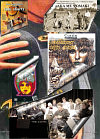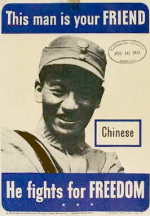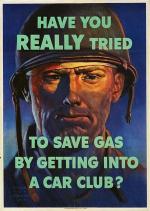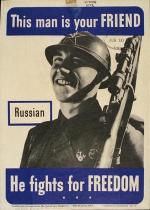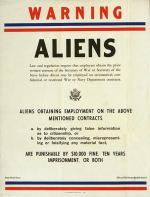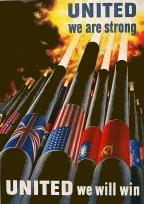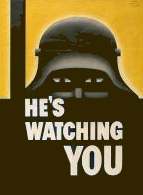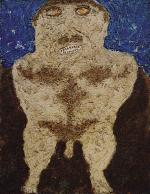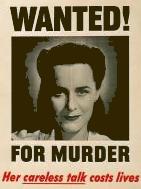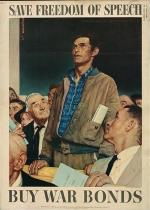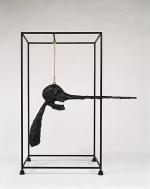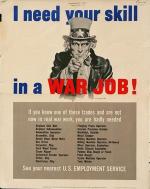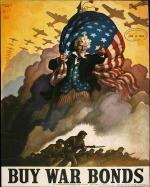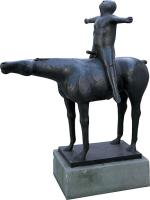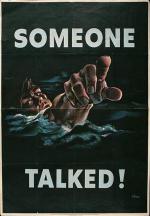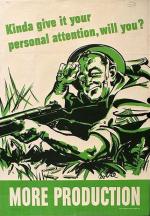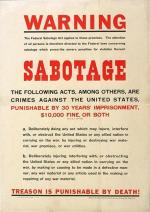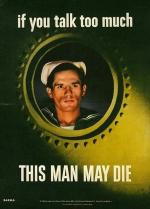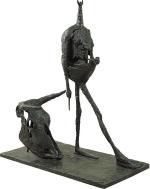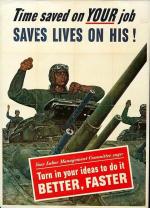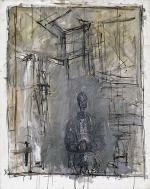Alexandria Virtual Cultural Centre of WA
Copyright © 1998- 2005 Nuclear Age Peace Foundation
It was not until July 13, 1942, in the midst of World War II, that the United States undertook the Manhattan Project to develop an atomic bomb. By December 2, a Manhattan Project team headed by Enrico Fermi produced the first artificial fission reaction at the University of Chicago. Three years after its inception, the Manhattan Project achieved its goal of developing an atomic weapon.
World War II ended in Europe on May 8, 1945, less than a month after the death of President Franklin Roosevelt, but plans for the development and use of atomic weapons continued.
At at 5:29 a.m. on July 16, 1945, the United States conducted the world's first nuclear test explosion at Alamogordo, New Mexico. The Nuclear Age was born, a product of the fear, violence, and suffering of World War II. J. Robert Oppenheimer, director of the Los Alamos Laboratory, recalled the following passage from the Bhagavad Gita upon witnessing the explosion: "I am become death, the destroyer of worlds"
Within a month, nuclear weapons were used to destroy the Japanese cities of Hiroshima and Nagasaki. When he received word of the bombing of Hiroshima, President Truman exclaimed, "This is the greatest day in history!"
On August 8, 1945, two days after the U.S. dropped an atomic bomb on Hiroshima, representatives of the U.S., United Kingdom, U.S.S.R., and France created an International Military Tribunal at Nuremberg to try Axix leaders for war crimes. Japan signed a surrender agreement on September 2, ending the war in the Pacific.
On October 24, 1945, the United Nations Charter entered into force and the new international organization was founded. Yet the good intentions of this new peacekeeping organization were threatened by the onset of the Cold War. At the first meeting of the Atomic Energy Commission, the U.S. delegate proposed a plan to internationalize control of atomic energy. The plan was rejected by the Soviet Union, which tested its first nuclear weapons in 1949, ending the U.S. monopoly.
By 1947 the Cold War was playing a major role in U.S. foreign policy. The National Security Act created the Central Intelligence Agency (CIA), and the Truman Dctrine proclaimed that the U.S. would assist any country threatened by Communist aggression.
The Cold War intensified in February 1948 when the Communists took over Czechoslovakia and the U.S.S.R. initiated the Berlin Blockade. That same year UN General Assembly adopted a Convention on the Prevention and Punishment of the Crime of Genocide and the Universal Declaration of Human Rights
By 1949 Chinese Communist insurgents led by Mao Tse-tung took power. The North Atlantic Treaty was signed, creating NATO, and the Berlin Blockade came to an end. In August, 1949, the USSR detonated its first atomic bomb.
The 1940s was the most violent decade of the century, ending with some 54,000,000 persons killed in warfare. Sixty percent were civilians.
The University of California begins building a giant cyclotron under the direction of Ernest O. Lawrence.Edwin McMillan bombards uranium with neutrons and produces the first "transuranic" element, neptunium (Atomic Number 93)
20 February
The German physicist Werner Heisenberg sends a secret report to the Army Weapons Bureau "On the Possibility of Technical Energy Production from Uranium Splitting. II.")
February 23
Glenn Seaborg and colleagues at the University of California at Berkeley find that neptunium emits beta rays (electrons), thereby forming another new element (Atomic Number 94) which they call plutonium. In 1951 Seaborg and Edwin McMillan receive a Nobel prize for their work.
June 28
Office of Scientific Research and Development is established under the direction of Vannevar Bush, to develop atomic energy.
September
Enrico Fermi suggests to Edward Teller that an atomic bomb might heat deuterium sufficiently to create a full-scale thermonuclear reaction.
October 9
President Roosevelt decides to proceed with development of an atomic weapon after a meeting in which he is informed of its feasibility.
December 6
The day before the bombing of Pearl Harbor, President Roosevelt authorizes the Manhattan Engineering District. The secret U.S. project to build an atomic bomb, later to be called the Manhattan Project, is put under the direction of the Office of Scientific Research and Development..
September 23
Colonel Leslie Groves is promoted to Brigadier-General and put in charge of the Manhattan Project. He recruits J. Robert Oppenheimer as Scientific Director.
November 16
Groves and Oppenheimer select the site of the boys' school Los Alamos in New Mexico for the project. Oppenheimer tours the United States recruiting top scientists and persuading them to move to New Mexico. Edward Teller is among the first group of 100 to accept.
December 2
Enrico Fermi and his team at the University of Chicago produce the world's first controlled and sustained nuclear fission reaction. Leo Szilard and Fermi originate the method of arranging graphite and uranium which makes the reaction possible.
April
Thirty scientists assemble at Los Alamos, New Mexico for an introductory series of lectures on the theory and practicalities of designing and building an atomic bomb using uranium-235 or plutonium-239.
May 5
The Military Policy Committee of Manhattan Project developes the idea to use the atomic bomb on Japan rather than on Germany. The committee is chaired by General Leslie Groves
A second uranium reactor is built at Clinton, Tennessee for manufacturing plutonium for an atomic bomb. [Note: First reactor is Fermi's in 1942.]
March 13
Barely sixteen months after the feasibility of achieving a self-sustaining nuclear chain reaction was established by Enrico Fermi in Chicago -- a tightly held secret known only to a very limited number of individuals in the U.S., UK and Canada - Homi Jehangir Bhabha initiates efforts to start nuclear research programms in India.
December 8
Joseph Rotblat, Polish refugee and physicist, resigns from the Manhattan Project since he believed that Nazi Germany would not succeed in developing an atomic weapon. He later explains, "I felt there was no need to make a bomb. The only reason I started in 1939 was to stop Hitler using it against us." Rotblat was thereafter barred from entering the United States for 20 years. In 1957 he helped start the Pugwash Conferences on Science and World Affairs, of which he was the first president. In 1995 Rotblat and Pugwash jointly were awarded The Nobel Peace Prize for their work towards the abolition of nuclear weapons.
1945 - The Decision to Drop the Bomb
The decision to drop the atomic bombs on the cities of Hiroshima and Nagasaki is one of the most controversial issues of the 20th century. Many modern historians have criticized the commonly held perceptions that the bomb shortened the war, saved American lives and prevented USSR's sharing in the post-war administration of Japan (see, for example, Hiroshima's Shadow edited by Kai Bird & Lawrence Lifschultz ). In 1995, on the 50th anniversary of the bombing, an exhibit designed to commemorate the event resulted in unprecedented controversy for the Smithsonian Institution. The American Legion and other veteran's organizations successfully lobbied against the inclusion of quotes from a number of notables including Dwight D. Eisenhower that questioned the necessity of the bomb's use.
The debate has not subsided. This timeline seeks to chronicle the events in 1945 leading up to and following the bombings. In 1945 the Manhattan Project, the ambitious and expensive US effort to create the atomic bomb, succeeded in its mission. The first atomic device was tested at Alamogordo, New Mexico on July 16, 1945. Three weeks later the atomic bomb was used on the city of Hiroshima, killing to 70,000 to 90,000 people-- overwhelmingly civilians-- immediately. Three days later the atomic bomb was used again on the city of Nagasaki, followed shortly by the end of World War II.
The decision to drop the first atomic bomb on Japan will remain relevant to our joint human experience forever. Important questions remain: Did it have to happen? Will it happen again in an even more catastrophic way? What do the first human experiences with nuclear power say about humanity's ability to control its most dangerous creation?
January 1945
U.S. scientists and physicians begin secret experiments on plutonium toxicity by injecting plutonium into patients and prisoners, without their knowledge or consent. A civilian consultant to Department of War, Jack Madigan, summarizes his findings on the efficacy of the Manhattan Project: "If the project succeeds there won't be any investigation. If it doesn't, they won't investigate anything else."
January 27
Soviet Army liberates Auschwitz
February 4-11
Roosevelt, Churchill and Stalin hold Conference at Yalta. They agree upon occupation zones for postwar Germany, a plan set up a new government for Poland, and " a general international organization to maintain peace and security."
February 13
Massive Allied bombing of Dresden creates firestorm for the second time in history. American author Kurt Vonnegut was present in Dresden and writes about it in Slaughterhouse Five.
March 3
Head of the War Mobilization Board and future Secretary of State James Byrnes sends a memo to Franklin Roosevelt warning that if there is no "product" before the end of the war "there would be serious consequences for the Democratic Party."
He also states, “I understand that the expenditures for the Manhattan Project are approaching two billion dollars with no definite assurance yet of production. We have succeeded to date in obtaining the co-operation of congressional committees in secret hearings. Perhaps we can continue to do so while the war lasts."
March 25
At the urging of Leo Szilard, Albert Einstein signs a letter of introduction of Szilard to President Roosevelt. Szilard wishes to warn Roosevelt of the post-war dangers of a nuclear arms race if the atomic bomb is used against Japan. The letter states: "The terms of secrecy under which Dr. Szilard is working at present do not permit him to give me information about his work; however, I understand that he now is greatly concerned about the lack of adequate contact between scientists who are doing this work and those members of your Cabinet who are responsible for formulating policy." In the memorandum accompanying the letter, Szilard wrote: "our 'demonstration' of atomic bombs will precipitate a race in the production of these devices between the United States and Russia and that if we continue to pursue the present course, our initial advantage may be lost very quickly in such a race."
April
Anne Frank (1929-1945) dies at a Nazi concentration camp in Bergan-Belsen. Her diary states,"It's really a wonder that I haven't dropped all my ideals, because they seem so absurd and impossible to carry out. Yet I keep them, because in spite of everything I still believe that people are really good at heart."
Eleanor Roosevelt, who received a copy of Szilard's letter to President Roosevelt, replies to Szilard proposing a meeting in her Manhattan apartment on May 8. The president, however, died on April 12.
April 12
Franklin Roosevelt dies, and Harry Truman becomes the 33rd President of the United States. In his last prepared speech he writes, "We are faced with the preeminent fact that if civilization is to survive we must cultivate the science of human relationship-- the ability of peoples of all kinds to live together and work together in the same world, at peace. We have learned and paid an awful price to learn, that living and working together can be done in only one way only -- under law. There is now truer and simpler idea in the world today. Unless it prevails, and unless by common struggle we are capable of new ways of thinking, mankind is doomed."
April 25
Secretary of War Stimson and General Groves brief President Truman on the bomb. In this briefing, Groves insists that Japan had always been the target of the bomb's use.
Joint Chief Planners advise Joint Chiefs of Staff that "unless a definition of unconditional surrender can be given which is acceptable to the Japanese, there is no alternative to annihilation and no prospect that the threat of absolute defeat will bring about capitulation."
April 26
Soviet and U.S. troops meet at Torqau on the Elbe.
April 27
The Target Committee meets for the first time to decide which Japanese cities to target with the atomic bomb. By the end of May the following cities are selected: Kyoto, Hiroshima, Kokura and Niigata. [See minutes of the second meeting of the Target Committee in Related Sites.] Eventually Kyoto is replaced by Nagasaki and the listed cities are spared further conventional bombing by the American Army Air Force.
April 29
In a report entitled Unconditional Surrender, the Joint Intelligence Committee informs the Joint Chiefs of Staff that "numbers of informed Japanese, both military and civilian, already realize the inevitability of absolute defeat."
May 3, 1945
Jimmy Byrnes is chosen as President Truman’s personal representative on the Interim Committee. (See May 9, 1945)
May 8
War in Europe ends.
May 9
The Interim Committee meets for the first time. Its purpose is "to study and report on the whole problem of temporary war controls and later publicity, and to survey and make recommendations on post war research, development and controls, as well as legislation necessary to effectuate them." Members of the Interim Committee are: Jimmy Byrnes, the Presidential’s personal representative; Ralph Bard, an undersecretary of the Navy; William Clayton, an assistant secretary at the State Department; Vannevar Bush, Director of the US Office of Scientific Research and Development and a former Dean of Engineering at MIT; James Conant, president of Harvard University and a distinguished chemist; and Karl Compton, president of MIT and a noted physicist.
May 12
William Donovan, Director of the Office of Strategic Services, reports to President Truman that Japan's minister to Switzerland, Shunichi Kase, wished "to help arrange for a cessation of hostilities."
May 25
Leo Szilard visits White House with letter of introduction from Albert Einstein to warn President Truman of the dangers atomic weapons pose for the post-War world and to urge him not to authorize use of atomic weapons against Japan. Szilard is referred Matthew J. Connelly, Truman's appointments secretary, to James Byrnes in Spartanburg, South Carolina.
May 28
Assistant Secretary of War John J. McCloy argues to Secretary of War Stimson that the term "unconditional surrender" should be dropped: "Unconditional surrender is a phrase which means loss of face and I wonder whether we cannot accomplish everything we want to accomplish in regard to Japan without the use of that term."
Leo Szilard, along with Walter Bartky and Harold Urey, meet with Jimmy Byrnes at his home in Spartanburg, South Carolina. Szilard attempts to persuade Byrnes to demonstrate the bomb’s power rather than using it on Japan. Byrnes asks Szilard, ”How would you get Congress to appropriate money for atomic energy research if you do not show results for the money which has been spent already?” Reflecting on this meeting later, Szilard writes, ”I thought to myself how much better off the world might be had I been born in America and become influential in American politics, and had Byrnes been born in Hungary and studied physics. In all probability there would then have been no atomic bomb and no danger of an arms race between America and Russia.”
In a State Department Memorandum of Conversation, Acting Secretary of State Joseph Grew describes a meeting with President Truman that day. Grew writes: "The greatest obstacle to unconditional surrender by the Japanese is their belief that this would entail the destruction or permanent removal of the Emperor and the institution of the Throne. If some indication can now be given the Japanese that they themselves, when once thoroughly defeated and rendered impotent to wage war in the future will be permitted to determine their own future political structure, they will be afforded a method of saving face without which surrender will be highly unlikely."
May 30
Wanting to influence the Interim Committee, Szilard arranges a meeting with Oppenheimer in Groves' office. Oppenheimer tells Szilard, "this is a weapon with no military significance. It will make a big bang - a very big bang - but it is not a weapon which is useful in war."
May 31
The Interim Committee agrees that "the most desirable target would be a vital war plant employing a large number of workers and closely surrounded by workers' houses." Among those agreeing is James Conant, the president of Harvard University.
The Office of Strategic Services (OSS) reports on receiving a Japanese peace feeler through a Japanese diplomat stationed in Portugal. The Japanese diplomat says that the actual terms are unimportant so long as the term "unconditional surrender" is not used.
June 1
Interim Committee makes formal decision decides not to warn the civilian populations of the targeted cities. The minutes for the Interim Committee meeting state: “Mr. Byrnes recommended and the Committee agreed, that the Secretary of War should be advised that, while recognizing that the final selection of the target was essentially a military decision, the present view of the Committee was that the bomb be used against Japan as soon as possible; that it be used on a war plant surrounded by workers’ homes; and that it be used without prior warning.”
June 9
Chief of Staff General George Marshall, in a memo to Secretary of War Stimson, writes, "We should cease talking about unconditional surrender of Japan and begin to define our true objective in terms of defeat and disarmament."
June 11
The Franck Committee on the social and political implications of the atomic bomb, headed by Nobel Laureate James Franck, issues a report advising against a surprise atomic bombing of Japan. The report states, "If we consider international agreement on total prevention of nuclear warfare as the paramount objective... this kind of introduction of atomic weapons to the world may easily destroy all our chances of success." The report correctly predicts that dropping an atomic bomb "will mean a flying start toward an unlimited armaments race."
June 14
The Franck Committee Report - with its recommendation that bomb be demonstrated to Japan before being used on civilians - is taken by Compton to Los Alamos, and copies were given to Fermi, Lawrence and Oppenheimer.
June 15, 1945
Joint War Plans Committee (JWPC), an advisory committee to the Joint Chiefs of Staff, concludes that about 40,000 Americans would die in the planned two stage assault on Japan.Â
June 16
Compton, Fermi, Lawrence and Oppenheimer conclude: "We can propose no technical demonstration likely to bring an end to the war; we see no acceptable alternative to direct military use."
June 17
McCloy tells Stimson that "there were no more cities to bomb, no more carriers to sink or battleships to shell; we had difficulty finding targets."
June 18
President Truman convenes a meeting of his chief advisors to discuss the military's contingency plans for the invasion of Japan. The invasion was to begin no earlier than November 1, 1945 and, according to Admiral William Leahy, "The invasion itself was never authorized." McCloy is asked to prepare language for what is to become Article 12 of the draft Potsdam Declaration. It specifies that the post-war Japanese government "may include a constitutional monarchy under the present dynasty."
Admiral Leahy makes diary entry noting, "It is my opinion at the present time that a surrender of Japan can be arranged with terms that can be accepted by Japan and that will make fully satisfactory provision for America's defense against future trans-Pacific aggression." He also notes that General Marshall believes that an invasion of Kyushu, the southern-most Japanese island, "will not cost us in casualties more than 63,000 of the 190,000 combatant troops estimated as necessary for the operation." This may be compared to later estimates, after the atomic bombings, of 500,000 to 1,000,000 American lives saved.
June 19
James Forrestal's diary describes top-secret "State-War-Navy Meeting" in which surrender terms are discussed. He writes, "Grew's proposal, in which Stimson most vigorously agrees, that something be done in the very near future to indicate to the Japanese what kind of surrender terms would be imposed upon them and particularly to indicate to them that they would be allowed to retain their own form of government and religious institutions while at the same time making it clear that we propose to eradicate completely all traces of Japanese militarism."
June 20
A meeting of the Supreme War Direction Council before Emperor Hirohito is held on the subject of ending the war. According to the U.S. Strategic Bombing Survey, "the Emperor, supported by the premier, foreign minister and Navy minister, declared for peace; the army minister and the two chiefs of staff did not concur."
June 26
United Nations Charter signed by delegates from fifty nations in San Francisco.
Stimson, Forrestal and Grew agree that a clarification of surrender terms should be issued well before an invasion and with "ample time to permit a national reaction to set in." The three agreed that "Japan is susceptible to reason."Â
June 27
Undersecretary of the Navy Ralph Bard sends a memo to Secretary of War Stimson recommending that “fair play” demanded that the US give the Japanese prior warning of an atomic attack. He recommends that the US give the Japanese ”information regarding the proposed use of atomic power.”
July 1
Szilard begins circulating a petition to President Truman calling expressing opposition on moral grounds to using the atomic bomb against Japan.
July 2
Secretary of War Henry Stimson advises Truman to offer a definition of unconditional surrender, and states, "I think the Japanese nation has the mental intelligence and versatile capacity in such a crisis to recognize the folly of a fight to the finish and to accept the proffer of what will amount to an unconditional surrender."
July 3
James Byrnes becomes U.S. Secretary of State.
New York Times reports, "Senator [William] White of Maine, the minority [Republican] leader, declared that the Pacific war might end quickly if President Truman would state, specifically, in the upper chamber just what unconditional surrender means for the Japanese."
July 4
Szilard writes to a colleague regarding the petition to president: "I personally feel it would be a matter of importance if a large number of scientists who have worked in this field went clearly and unmistakably on record as to their opposition on moral grounds to the use of these bombs in the present phase of the war."
July 7
Truman leaves for Potsdam on the Augusta accompanied by Secretary of State Byrnes. They are one day at sea, when Byrnes receives telegram from Acting Secretary of State Joseph Grew describing a peace overture from the Japanese military attach in Stockholm. The attach offered a negotiated settlement of the war if the US would guarantee the reign of the Emperor.
July 10
At a meeting of the Supreme War Direction Council, Emperor Hirohito urges haste in moves to mediate the peace through Russia.
July 13
Washington intercepts and decodes a cable from Japanese Foreign Minister Shigenori Togo to his Ambassador in Moscow that states, "Unconditional surrender is the only obstacle to peace."
Secretary of Navy Forrestal writes in his secret diary: "The first real evidence of a Japanese desire to get out of the war came today through intercepted messages from Togo, Foreign Minister, to Sato, Jap Ambassador in Moscow, instructing the latter to see Molotov if possible before his departure for the Big Three meeting and if not then immediately afterward to lay before him the Emperor's strong desire to secure a a termination of the war."
Farrington Daniels, Director of the Met Lab at the University of Chicago, reported to James Compton that 72 percent of the scientists favored a military demonstration of the bomb in Japan or in the U.S. with Japanese representatives present before using the weapon on civilians.
July 15
President Truman lands at Antwerp on his way to Potsdam meeting. Byrnes has convinced him to drop Article 12 of the Potsdam Declaration, which had provided assurance that the Emperor would be allowed to retain his throne as a constitutional monarch.
July 16
Trinity test, a plutonium implosion device, takes place at 5:29:45 a.m. mountain war time at Alamogordo, New Mexico. It is the world's first atomic detonation. The device has a yield of 19 kilotons, which is equivalent to 19,000 tons of TNT. J. Robert Oppenheimer recalls a quote from the Bhagavad Gita, a Hindu text: "I am become death, the destroyer of worlds." Brigadier General T.F. Farrell, General Groves' deputy commander, describes the explosion in this way: "The effects could well be called unprecedented, magnificent, beautiful, stupendous, and terrifying. The lighting effects beggared description. The whole country was lighted by a searing light with the intensity many times that of the midday sun. It was golden, purple, violet, gray, and blue. It lighted every peak, crevasse and ridge of the nearby mountain range with a clarity and beauty that cannot be described but must be seen to be imagined..."
July 17
President Truman at Potsdam writes in his diary, "Just spend [sic] a couple of hours with Stalin. He'll be in the Jap War on August 15th. Fini Japs when that comes about."
Secretary of War Stimson records in his diary: ”Byrnes was opposed to a prompt and early warning to Japan which I first suggested. He outlined a timetable on the subject [of] warning which apparently had been agreed to by the president, so I pressed it no further.”
Leo Szilard, unaware of Trinity test, prepares final draft of Petition to the President of the United States, calling on the President to "exercise your power as Commander-in-Chief to rule that the United States shall not resort to the use of atomic bombs in this war unless the terms which will be imposed upon Japan have been made public in detail and Japan knowing these terms has refused to surrender; second, that in such an event the question whether or not to use atomic bombs be decided by you in the light of the considerations presented in this petition as well as all other moral responsibilities which are involved." The petition was signed by 155 Manhattan Project scientists.
July 18
President Truman writes in his diary, "P.M. [Churchill] & I ate alone. Discussed Manhattan (it is a success). Decided to tell Stalin about it. Stalin had told P.M. of telegram from Jap Emperor asking for peace. Stalin also read his answer to me. It was satisfactory. Believe the Japs will fold up before Russia comes in. I am sure they will when Manhattan [reference to Manhattan Project] appears over their homeland. I shall inform about it at an opportune time.”
July 21
President Truman approves order for atomic bombs to be used.
July 23
UK Prime Minister Winston Churchill remarks, "[I]t is quite clear that the United States do not at the present time desire Russian participation in the war against Japan."
July 23 and 24
McCloy writes in diary in Potsdam, "Throughout it all the 'big bomb' is playing its part - it has stiffened both the Prime Minister and the President. After getting Groves' report they went to the next meeting like little boys with a big red apple secreted on their persons."
July 24
Walter Brown, special assistant to Secretary of State Byrnes, writes in his journal that Byrnes was now "hoping for time, believing after atomic bomb Japan will surrender and Russia will not get in so much on the kill, thereby being in a position to press claims against China."
Secretary of War Henry Stimson passes on orders for atomic attack.
July 25
President Truman writes in his diary: "We have discovered the most terrible bomb in the history of the world. It may be the fire destruction prophesied in the Euphrates Valley era, after Noah and his fabulous ark. Anyway we think we have found the way to cause a disintegration of the atom. An experiment in the New Mexican desert was startling - to put it mildly”. This weapon is to be used against Japan between now and August 10. I have told the secretary of war, Mr. Stimson, to use it so that military objectives and soldiers are the target and not women and children. Even if the Japs are savages, ruthless, merciless and fanatic, we as the leader of the world for the common welfare cannot drop this terrible bomb on the old capital or the new. He and I are in accord. The target will be a purely military one and we will issue a warning statement asking the Japs to surrender and save lives. I'm sure they will not do that, but we will have given them the chance. It is certainly a good thing for the world that Hitler's crowd or Stalin's did not discover this atomic bomb. It seems to be the most terrible thing ever discovered, but it can be made the most useful."
General Carl Spatz, commander of the United States Army Strategic Air Forces, receives the only written order on the use of atomic weapons from acting Chief of Staff, General Thomas Handy.
July 26
Potsdam Declaration calls upon Japanese government "to proclaim now the unconditional surrender of all Japanese armed forces." The alternative, the Declaration states, is "prompt and utter destruction."
Forrestal secret diary states, "In the past days Sato in Moscow has been sending the strongest language to the Foreign Office at Tokyo his urgent advice for Japan to surrender unconditionally. Each time the Foreign Minister, Togo, responds by saying that they want Sato to arrange for the Russians to receive Prince Konoye as a special representative of the Emperor to Moscow. Sato's persistent reply to these messages was that this is a futile hope, that there is no possibility of splitting the concert of action now existing between Great Britain, the United States and Russia."
July 28
U.S. Senate approves the U.N. Charter by a vote of 98 to two.
Japan rejects Potsdam Declaration.
August 3
President Truman aboard Augusta receives new report that Japan is seeking peace. Walter Brown, special assistant to Secretary of State Byrnes, writes in his diary, "Aboard Augusta - President, Leahy, JFB agreed Japs looking for peace. (Leahy had another report from Pacific.) President afraid they will sue for peace through Russia instead of some country like Sweden."
August 6
The world's second atomic bomb, Little Boy, a gun-type uranium bomb, is detonated 1,900 feet above Hiroshima, Japan. It has a yield of approximately 15 kilotons TNT. Some 90,000 to 100,000 persons are killed immediately; about 145,000 persons will perish from the bombing by the end of 1945.
Upon hearing the news of the atomic bombing of Japan on his way home from Potsdam, President Truman remarked that this was "the greatest thing in history."
Leo Szilard, the atomic scientist who had worked so hard to prevent the use of the bomb, writes to a friend, "Using atomic bombs against Japan is one of the greatest blunders of history."
August 7
Decision is made to drop warning pamphlets on Japanese cities.
August 8
Soviet Union informs Japan that it is entering the war.
Decision is made to set up International Tribunal at Nuremberg.
August 9
At 9:44 a.m. Bockscar, a B-29 carrying Fat Man, the world's third atomic bomb, arrives at its primary target, Kokura. The city is covered in haze and smoke from an American bombing raid on a nearby city. Bockscar turns to its secondary target Nagasaki. At 11:02 a.m. the world's third atomic bomb explosion devastates Nagasaki, the intense heat and blast indiscriminately slaughters its inhabitants.
President Truman speaks to the American people via radio broadcast. He states, "The world will note that the first atomic bomb was dropped on Hiroshima, a military base. That was because we wished in the first instance to avoid, in so far as possible, the killing of civilians." [The official Bombing Survey Report stated: "Hiroshima and Nagasaki were chosen as targets because of their concentration of activities and population." More than 95 percent of those killed at Hiroshima and Nagasaki were civilians.]
Atomic bomb dropped on Nagasaki.
Soviet Union begins its offensive against Japan in Manchuria.
August 10
U.S. drops warning leaflets on Nagasaki on the day after the bombing.
August 12
Manhattan Project releases report, Atomic Energy for Military Purposes, written by physicist Henry DeWolf Smyth. The report, known as the "Smyth Report," discusses the workings of the Manhattan Project, the basics of nuclear physics and some of the technologies used in producing plutonium and enriching uranium.
August 13-14
Japanese physicists investigating the epicenter of the Hiroshima bomb burst start noticing high levels of radioactivity.
August 14
Japan surrenders.
August 15
Emperor Hirohito of Japan, in a radio broadcast to his nation announces that Japan has lost the war. The Emperor's announcement is hard to understand because he speaks in archaic court Japanese, but one fact is understood: "Moreover, the enemy has begun to employ a new and most cruel bomb, the power of which to damage is indeed incalcuable, taking the toll of many innocent lives."
New York Times reports, "Russia's entry into the Japanese war was the decisive factor in speeding its end and would have been so, even if no atomic bombs had been dropped, is the opinion of Major-General Claire Chennault..."
August 24
Soviet Union announces that the Japanese Manchurian Army has surrendered.
September 2
Japan formally signs documents of surrender.
September 9
The Trintiy test site is opened to the press for the first time. General Groves and J. Robert Oppenheimer dispel rumors of lingering high radiation levels there.
September 20
The U.S. Joint Chiefs of Staff embrace "first strike" atomic warfare policy.
October
Robert Oppenheimer refuses to participate in a full fledged effort to build a hydrogen bomb when approached by Edward Teller.
October 18
Top-secret documents from the Los Alamos National Laboratory reach the desk of Lavrenty Beria, head of the Soviet secret police and in charge of the Soviet nuclear program.
November
Albert Einstein makes a plea for world government. He states, "Since I do not foresee that atomic energy is to be a great boon for a long time, I have to say that for the present, it is a menace."
November 15
President Harry Truman and Prime Ministers Clement Attlee of Great Britain and Mackenzie King of Canada call for a UN Atomic Energy Commission. Declaration | Joint Statement
November 21
Judge Robert H. Jackson makes the opening statement on behalf of the United States at the International Military Tribunal of Nazi war criminals at Nuremberg. Jackson states: "We must never forget that the record on which we judge these defendants today is the record on which history will judge us tomorrow. To pass these defendants a poisoned chalice is to put it to our own lips as well. We must summon such detachment and intellectual integrity to our task that this trial will commend itself to posterity as fulfilling humanity's aspiration to do justice."
November 23
In a secret agreement between the USSR and the CSSR the Soviet Union secures exclusive rights to all uranium mined within Czechoslovakia.
December 10
Eugene Rabinowitch and Hyman Goldsmith publish first issue of The Bulletin of the Atomic Scientist.
December 19
Nuclear research begins in India with establishment of Tata Institute of Fundamental Research (TIFR) with Homi Jehangir Bhabha as its first director.
December 24
U.S. Embassy in Moscow warns of an all-out Soviet effort to build atomic bomb.
1946
January 10
United Nations General Assembly holds its opening session in Central Hall, Westminster in the UK.
January 24
The UN General Assembly adopts its first resolution, which establishes an Atomic Energy Commission (AEC) and calls for the "elimination from national armaments of atomic weapons and all other major weapons adaptable to mass destruction."
Febuary 9
Joseph Stalin delivers a speech at the Bolshoi Theater which marks a deterioration in Soviet-American relations.
February 16
Faculty of Columbia University, including physicist Isidor Rabi, urges President Truman to stop production of atomic bombs.
February 22
George F. Kennan, Chargé d'affaires in Moscow, sends historic long telegram to the U.S. State Department. It analyzes Soviet foreign policy in alarming terms.
March 5
Winston Churchill delivers historic Iron Curtain Speech at Fulton, Missouri.
March 28
Acheson-Lilienthal Report on the International Control of Atomic Energy is released stating, "Only if the dangerous aspects of atomic energy are taken out of national hands...is there any reasonable prospect of devising safeguards against the use of atomic energy for atomic bombs."
April
Soviet scientist Lulii Khariton chooses a remote and scenic location near the village of Arzamas (now Sarov), about 400 miles east of Moscow, as secret location for Soviet weapons lab. Khariton will serve as scientific director of Arzamas-16 from 1946 until 1992.
April 18
During a top-secret, three-day conference at Los Alamos, New Mexico scientists examine feasibility of developing the hydrogen bomb.
June 14
At the first meeting of the United Nations Atomic Energy Commission, U.S. delegate Bernard Baruch presents a modified Acheson-Lilienthal Proposal to internationalize control of atomic energy. He announces, "We are here to make a choice between the quick and the dead. That is our business. Behind the black portent of the new atomic age lies a hope, which seized upon in faith, can work our salvation. If we fail, then we have damned every man to be the slave of Fear. Let us not deceive ourselves. We must elect World Peace or World Destruction."
June 19
Andrei Gromyko, Soviet delegate to the UN Atomic Energy Commission insists that any agreement on the international control of atomic weapons must be preceded by a worldwide moratorium on their production and use.
July 1
The United States begins nuclear weapons testing at Bikini Atoll in the Pacific by initiating Operation Crossroads.
August 1
The United States Congress establishes its own Atomic Energy Commission (AEC) to control U.S. nuclear energy development.
August 31
"Hiroshima" by John Hersey is published in the New Yorker magazine, revealing the horrors of atomic war to the American public.
November 10
Team of Soviet scientists, headed by Igor Kurchatov, begins assembly of first full-scale nuclear reactor.
December 25
The Soviet Union achieves its first nuclear chain reaction in Moscow, using an experimental graphite-moderated natural uranium pile.
December 30
The UN Atomic Energy Commission approves the Baruch plan calling for the creation of an international atomic development authority. In doing so, it rejects the Soviet plan which called for nuclear disarmament before any international agency is created.
December 31
Soviet scientists review "classical super," Edward Teller's design for the hydrogen bomb.
1947
April 17
US Atomic Energy Commission issues a memo on "Medical Experiments on Humans." It reads in part, "It is desired that no document be released which refers to experiments with humans and might have adverse effect on public opinion or result in legal suits. Documents covering such work field should be classified 'secret'."
June 5
U.S. Secretary of State George Marshall announces European Recovery Program, a.k.a. Marshall Plan.
July
George F. Kennan, U.S. Chargé d'affaires in Moscow, outlines policy of political containment of Soviet Union.
August
The United Kingdom's first atomic reactor at Harwell comes into operation.
September 28
British physicist Klaus Fuchs meets with his agent Alexander Feklisov in London and describes certain structural characteristics of the hydrogen bomb.
October
Nuclear war plans of U.S. Joint Chiefs of Staff considers 150 "Nagasaki type" sufficient to defeat the USSR. Nuclear weapons stockpile is still small (20-50) but growing.
1948
The Military and Political Consequences of Atomic Energy by P. M. S. Blackett argues that the United Kingdom cannot achieve an independent nuclear deterrent. As a result, the government blacklists Blackett for over a decade.
January 7
U.S. and Great Britain revoke wartime pact on nuclear cooperation.
February 25
Soviet forces occupy Prague, capital city of Czechoslovakia.
March 13
British physicist Klaus Fuchs delivers "classical super" design for the construction of the hydrogen bomb to his agent, Alexander Feklisov.
April
U.S. Atomic Energy Commission begins Operation Sandstone at Eniwetok Atoll in the Pacific to test the improved designs of fission bombs.
May 5
Joint Chiefs of Staff brief President Truman on "Halfmoon," their nuclear war plan. The plan calls for dropping 50 atomic bombs on 20 Russian cities. Truman disapproves.
June
Soviet physicist Igor Tamm enlists his graduate student Andrei Sakharov to study fusion problem.
June 7
Reactor A at the Mayak complex near Chelyabinsk reaches full criticality, enabling the USSR to produce plutonium.
June 19
First Soviet plutonium production reactor becomes operational at Kyshtym in the Ural Mountains.
June 24
USSR blocks rail and road connections to West Berlin.
July
Soviet physicist Andrei Sakharov begins development of "Layer Cake" concept for hydrogen bomb.
October 19
General Curtis LeMay assumes command of the U.S. Strategic Air Command.
1949
The Weizmann Institute of Science in Israel actively supports nuclear research.
January
Soviet physicist Andrei Sakharov starts working at the secret Arzamas-16 nuclear weapons laboratory.
February 27
Plutonium separation begins at the Mayak complex near Chelyabinsk begins, dumping highly radioactive waste into the Techa river. Radioactivity from the Techa river is discovered in the Arctic as early as 1951.
March
General Curtis LeMay's first nuclear war plan for the Strategic Air Command envisions attacks on 70 Soviet cities with 133 bombs.
April 4
The North Atlantic Treaty establishes NATO, a military alliance aimed at protecting Western nations from the Soviet bloc.
May 15
Communists win elections in Hungary.
July
Physicist Edward Teller rejoins the staff at Los Alamos, New Mexico.
July 29
UN Atomic Energy Commission suspends its meetings because of irreconcilable differences between the U.S. and USSR. [see December 30, 1946]
August 29
Soviet Union detonates its first atomic bomb, Joe 1 (10-20 kilotons) at Semipalatinsk in Kazakhstan. Top Secret Policy Planning Staff Memo
September 3
U.S. weather plane flying off the coast of Siberia picks up evidence of radioactivity. Report by Chief of Staff
September 23
President Truman announces explosion of first Soviet atomic bomb.- Text
October
U.S. government expands production of uranium and plutonium.
October 29
General Advisory Committee to the U.S. Atomic Energy Commission argues against a crash program to develop the hydrogen bomb. - Minutes | Report
November 25
In a letter Atomic Energy Commissioner Lewis Strauss urges President Truman to give highest priority to development of hydrogen bomb.
December 2 and 3
Hanford Nuclear Plant releases three tons of irradiated uranium fuel in an experiment called Green Run aimed at duplicating pollution from a Soviet reactor. The experiment places more than 7,800 curies of radioactive iodine-131, known to cause thyroid cancer in humans, into the environment. This classified atomic intelligence experiment was not disclosed for almost four decades.
Copyright © 1998- 2005 Nuclear Age Peace Foundation
Virtual Cultural Centre of WA



